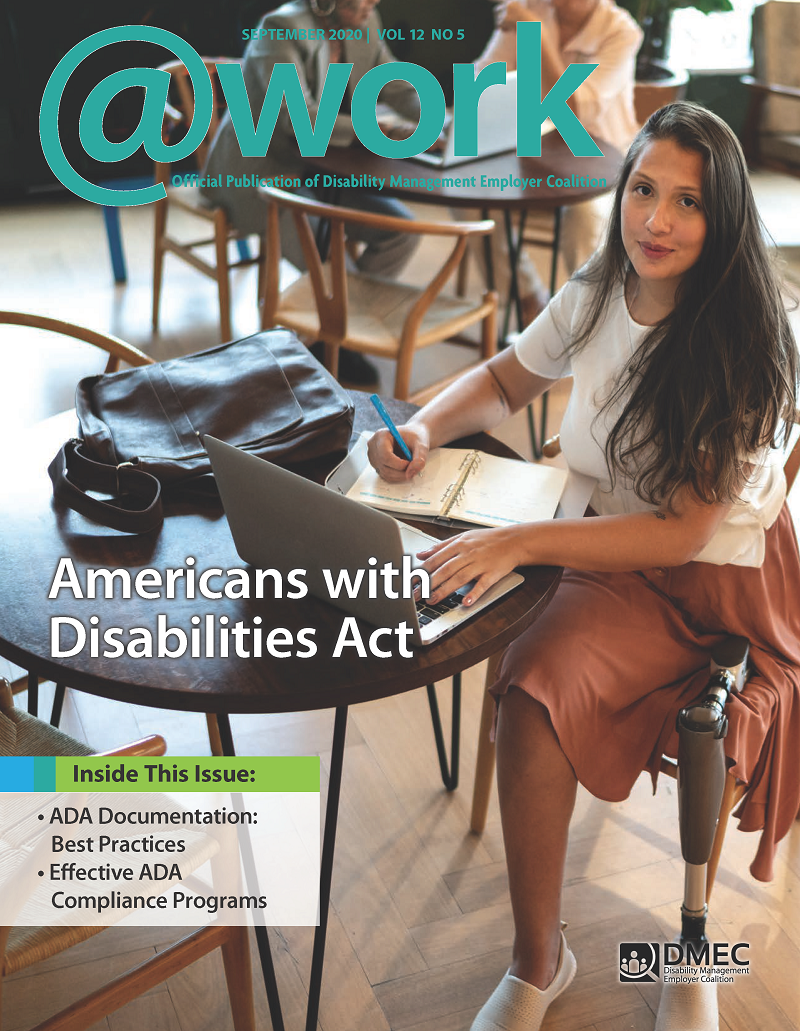
September 2020
Americans with Disabilities Act
The Americans with Disabilities Act (ADA) was signed into law on July 26, 1990. As ADA accommodation programs and processes have been fine-tuned over the last 30 years, court cases continue to clarify the law's interpretation and organizations continue to grapple with integration and compliance. This issue of @Work magazine provides best practices for some of the most challenging pieces of the ADA, including documentation, coordination, and training.
Features
ADA Documentation: Implement Best Practices and Avoid Mistakes
Employers must be thoughtful in their approach to ADA documentation, particularly in reviewing requests for accommodation and engaging with the employee in the interactive process. Employers that take a thorough and considerate approach to employee accommodations and maintain written documentation of their efforts will be best positioned to defend their actions if litigation later arises. Read more.

Cost Savings Built in Los Angeles: An Effective ADA Disability Compliance Program
In 2016, Los Angeles County Metropolitan Transportation Authority made the decision to completely revamp how disability compliance was performed at the agency. Nearly three years later, the program has seen great success. Since implementation, it has not lost one ADA case, and the program has gained the trust and support of its internal stakeholders and union partners. Read more.

Spotlight Articles
Program Showcase: ADAAA & Career Mobility
Companies may take different approaches to providing effective accommodations. While some organizations focus on compliance, others develop and integrate initiatives within their overall HR strategy. At Baystate Health, an ADA/ADAAA Case Management Program has been integrated with a Career Mobility Program to expand the range of accommodation options available to employees with disabling conditions. Read more.

Compliance Showcase: ADAAA Practices
Ensuring that ADAAA services and approvals are consistent can be especially challenging due to numerous internal ADAAA decision-makers, variable levels of documentation, inconsistent training for human resources business partners, and merging of practices due to an acquisition. Several critical best practices help to ensure that an organization with multiple locations is able to uphold consistent standards in managing ADAAA requests. Read more.

RTW Showcase: ADA Documentation
Effective absence management solutions include stay-at-work and return-to-work programs offering transitional duty or alternative work accommodations after an injury has occurred. Employers can also use these programs proactively to help prevent injuries, especially among older employees who may struggle with the physical demands of a job. Read more.

Columns
Absence Matters: ADA and Leave Rights Intersection
How does the Americans with Disabilities Act intersect with other types of leave? This question can prove vexing for employers when faced with the simultaneous needs of the employee, the organization, and compliance. Read more.

Integrated Absence Management: Employer Communication
The evidence is clear: effective and timely employer communication positively influences what happens after an employee becomes disabled. Positive impacts occur in return to work, healthcare, retention and engagement, and preventing conflicts and litigation. Read more.

Engaging Today’s Workforce: ADA Compliance
Many employers are wondering how to stay ADA compliant as they strive to keep their workplace and employees safe during the COVID-19 pandemic and as employees return to work. Recognizing the growing need for information on this topic, the Equal Employment Opportunity Commission updated its ADA guidance document. Read more.

Employer Solutions: Documenting Essential Job Functions
A required data point under the Americans with Disabilities Act (ADA), essential job functions help an employer identify potential accommodations to help an ill or injured employee continue to do that job. Essential job functions also are one of the first things the Equal Opportunity Employment Commission looks for when investigating ADA complaints. Read more.

FMLA & ADA Medical Information: Unreasonable Accommodations
It is not uncommon for an employee to supply medical certifications that seem to have been dictated by the employee, rather than objective medical findings from a healthcare professional. The ADA allows an employer to send an employee for an ADA-compliant medical exam. Read more.

IAM Technology Tips: Self-Service Tools
Most employers and administrators engage in the interactive process via meetings, phone calls, emails, and documents. Keeping track of the process proves more difficult with each passing year. Employers who were forced to utilize online sharing tools due to pandemic conditions should consider enhancing those tools for their accommodations interactive process. Read more.

Absence & Accommodation Technology: Efficiency and Compliance
Employers turn to leave management technology primarily for efficiency and compliance, both of which require accurate data flowing from other human resources systems. When it comes to data integration and efficiency, the goal is to reduce redundant data entry. Read more.

Common Sense Compliance: Accommodation Decisions
As we celebrate the 30th anniversary of the Americans with Disabilities Act, here are some common-sense tips about the interactive process and reasonable accommodation that may reduce employer costs in the long run. Read more.

A Clinician’s Viewpoint: Supporting ADA Compliance Efforts
While compliance with the Americans with Disabilities Act (ADA) is generally assigned to human resources, employers can use the help of clinicians to build programs that facilitate ADA compliance. Read more.

Workplace Mental Health: ADA Accommodations
Employers are well positioned to create supportive and inclusive workplaces for people experiencing mental health conditions, making it more likely that people will feel psychologically safe to come forward for work-related support when it’s needed. That’s not only good for individuals but also good for business in retaining a strong workforce, keeping overall healthcare costs down, and disability rates lower. Read more.

Benefits & Risk Management: The Aging Workforce
Our physical and mental abilities and requirements change as we age even in the absence of injuries or illness. When does “aging in place” to maintain employee productivity trigger a need for reasonable accommodations under the Americans with Disabilities Act interactive process? Read more.

Departments
The CEO’s Desk: 30 Years of Accommodations
As we consider the swift responses made recently to move workforces to remote work, what other obstacles and barriers might we be able to overcome related to other ADA concerns? Are there quicker and easier ways to help employees with qualified disabilities keep working? Is there an opportunity for changing the process to be more streamlined? Read more.

DMEC News: September 2020
During the month of August, DMEC hosted the 2020 DMEC Virtual Annual Conference. The coronavirus and its implications for employers continue to be at the forefront of everyone’s minds, and this year’s virtual conference focused on the theme of COVID-19: The Post-Pandemic Workforce. Read more.

Compliance Memos: September 2020
The September 2020 compliance memos cover a federal court ruling on the FFCRA, a settlement in a nursing mother case, new DOL forms, and updates from the DOL on the FMLA, the FFCRA, and the FLSA . Read more.





